Financial Analysis of Corus Entertainment (Intermediate Accounting)
VerifiedAdded on 2020/05/16
|6
|948
|238
Report
AI Summary
This report provides a comprehensive financial analysis of Corus Entertainment, examining its performance through horizontal and vertical analysis, as well as various financial ratios. The analysis covers profitability, efficiency, solvency, and liquidity ratios, providing insights into the company's financial health and trends from 2016 to 2017. The report highlights key findings, such as changes in revenue, expenses, net income, and asset/liability structures. It also assesses the company's debt levels, operational efficiency, and ability to meet obligations. Furthermore, the report offers recommendations for potential creditors and shareholders based on the financial analysis, considering the company's strengths and weaknesses. The study references academic sources to support its findings and conclusions, offering a well-rounded perspective on Corus Entertainment's financial standing.
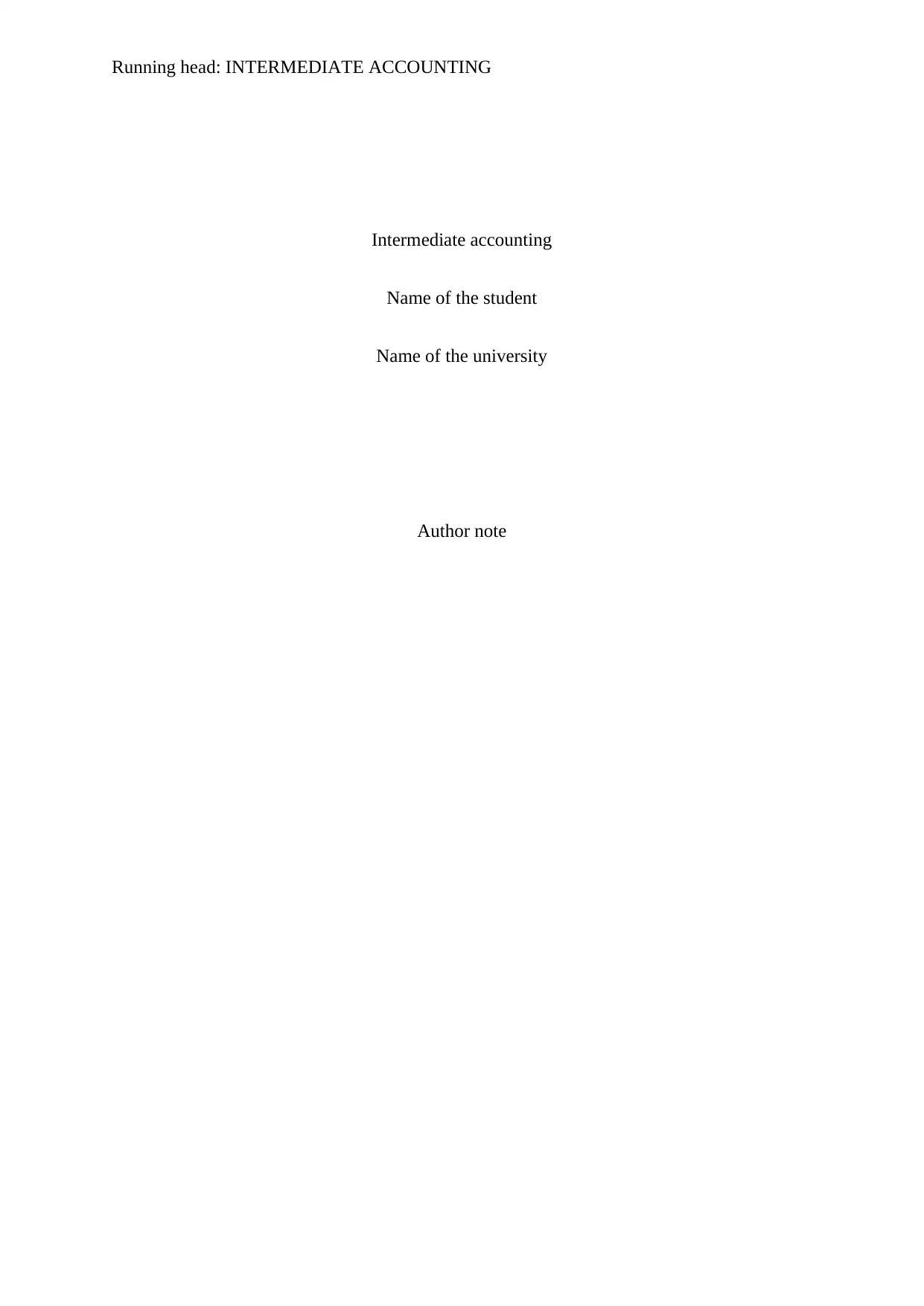
Running head: INTERMEDIATE ACCOUNTING
Intermediate accounting
Name of the student
Name of the university
Author note
Intermediate accounting
Name of the student
Name of the university
Author note
Paraphrase This Document
Need a fresh take? Get an instant paraphrase of this document with our AI Paraphraser
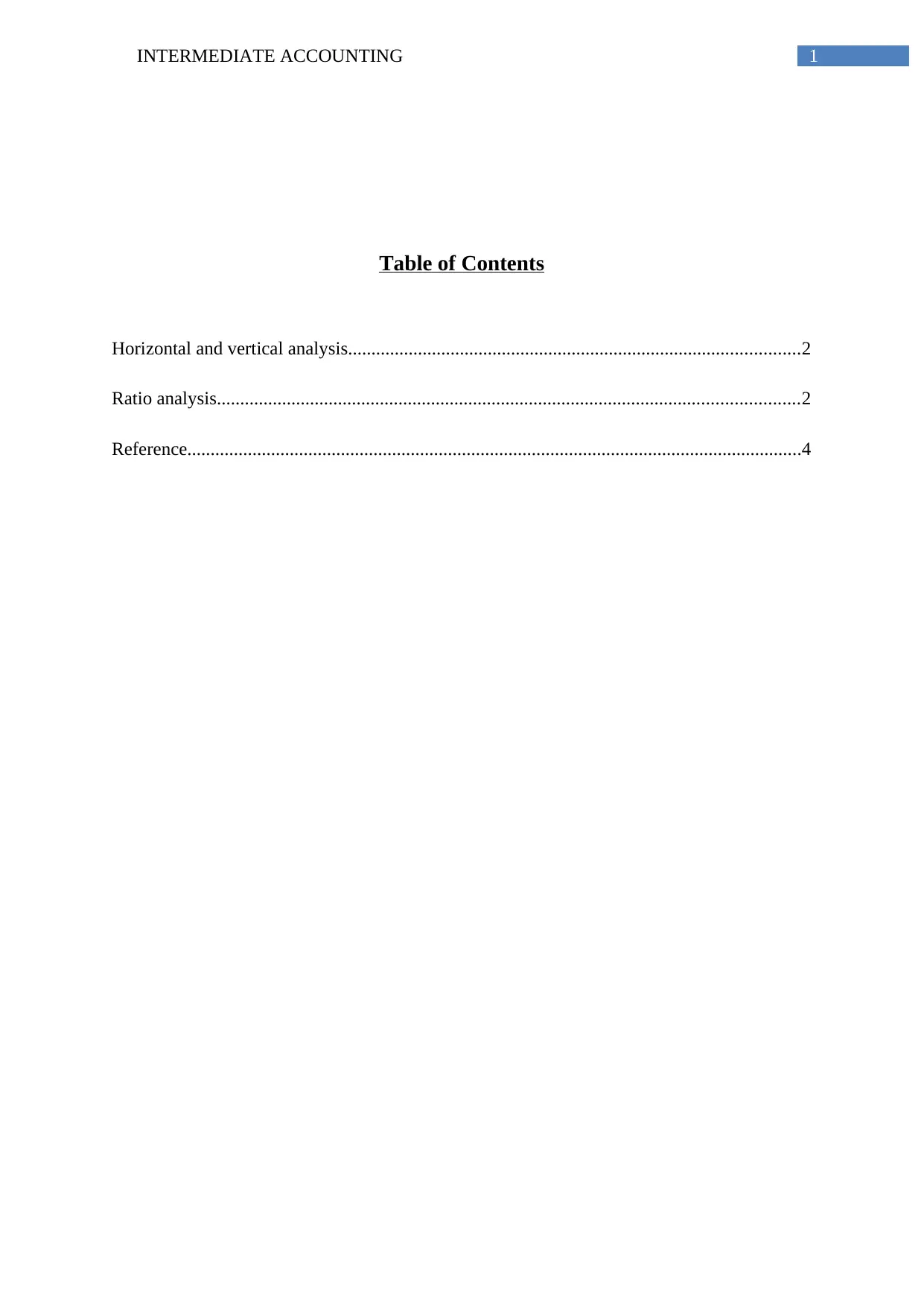
1INTERMEDIATE ACCOUNTING
Table of Contents
Horizontal and vertical analysis.................................................................................................2
Ratio analysis.............................................................................................................................2
Reference....................................................................................................................................4
Table of Contents
Horizontal and vertical analysis.................................................................................................2
Ratio analysis.............................................................................................................................2
Reference....................................................................................................................................4
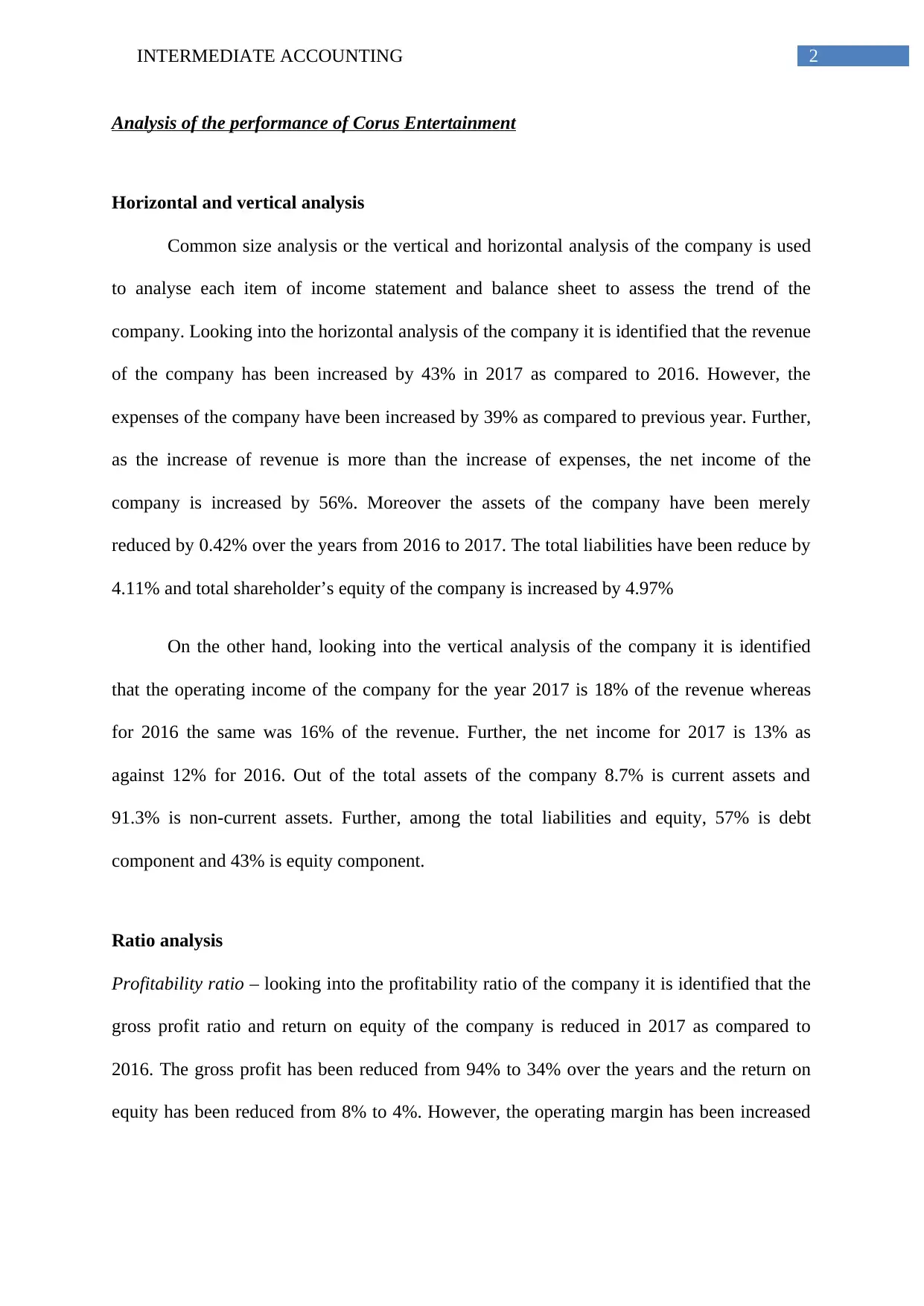
2INTERMEDIATE ACCOUNTING
Analysis of the performance of Corus Entertainment
Horizontal and vertical analysis
Common size analysis or the vertical and horizontal analysis of the company is used
to analyse each item of income statement and balance sheet to assess the trend of the
company. Looking into the horizontal analysis of the company it is identified that the revenue
of the company has been increased by 43% in 2017 as compared to 2016. However, the
expenses of the company have been increased by 39% as compared to previous year. Further,
as the increase of revenue is more than the increase of expenses, the net income of the
company is increased by 56%. Moreover the assets of the company have been merely
reduced by 0.42% over the years from 2016 to 2017. The total liabilities have been reduce by
4.11% and total shareholder’s equity of the company is increased by 4.97%
On the other hand, looking into the vertical analysis of the company it is identified
that the operating income of the company for the year 2017 is 18% of the revenue whereas
for 2016 the same was 16% of the revenue. Further, the net income for 2017 is 13% as
against 12% for 2016. Out of the total assets of the company 8.7% is current assets and
91.3% is non-current assets. Further, among the total liabilities and equity, 57% is debt
component and 43% is equity component.
Ratio analysis
Profitability ratio – looking into the profitability ratio of the company it is identified that the
gross profit ratio and return on equity of the company is reduced in 2017 as compared to
2016. The gross profit has been reduced from 94% to 34% over the years and the return on
equity has been reduced from 8% to 4%. However, the operating margin has been increased
Analysis of the performance of Corus Entertainment
Horizontal and vertical analysis
Common size analysis or the vertical and horizontal analysis of the company is used
to analyse each item of income statement and balance sheet to assess the trend of the
company. Looking into the horizontal analysis of the company it is identified that the revenue
of the company has been increased by 43% in 2017 as compared to 2016. However, the
expenses of the company have been increased by 39% as compared to previous year. Further,
as the increase of revenue is more than the increase of expenses, the net income of the
company is increased by 56%. Moreover the assets of the company have been merely
reduced by 0.42% over the years from 2016 to 2017. The total liabilities have been reduce by
4.11% and total shareholder’s equity of the company is increased by 4.97%
On the other hand, looking into the vertical analysis of the company it is identified
that the operating income of the company for the year 2017 is 18% of the revenue whereas
for 2016 the same was 16% of the revenue. Further, the net income for 2017 is 13% as
against 12% for 2016. Out of the total assets of the company 8.7% is current assets and
91.3% is non-current assets. Further, among the total liabilities and equity, 57% is debt
component and 43% is equity component.
Ratio analysis
Profitability ratio – looking into the profitability ratio of the company it is identified that the
gross profit ratio and return on equity of the company is reduced in 2017 as compared to
2016. The gross profit has been reduced from 94% to 34% over the years and the return on
equity has been reduced from 8% to 4%. However, the operating margin has been increased
⊘ This is a preview!⊘
Do you want full access?
Subscribe today to unlock all pages.

Trusted by 1+ million students worldwide
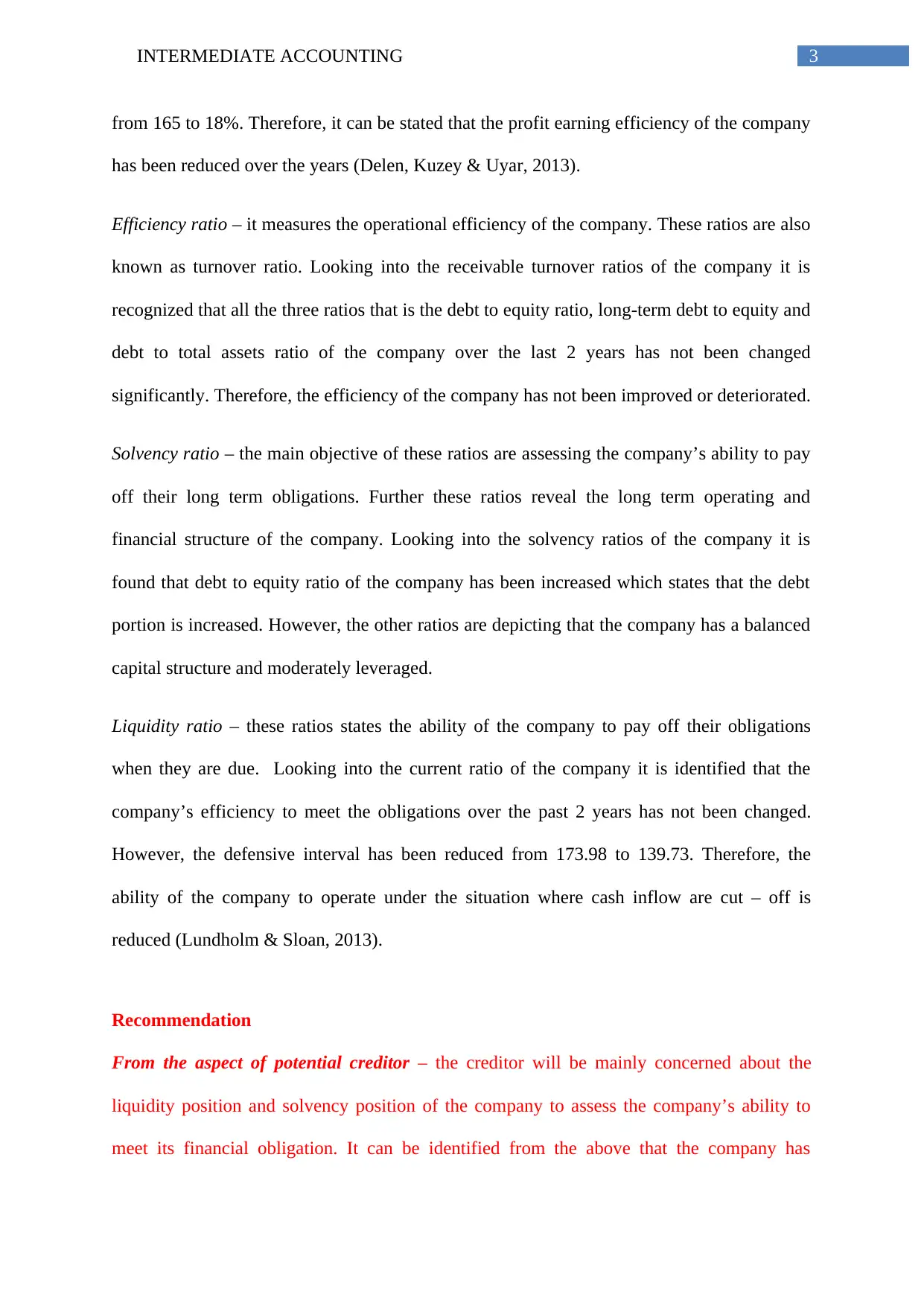
3INTERMEDIATE ACCOUNTING
from 165 to 18%. Therefore, it can be stated that the profit earning efficiency of the company
has been reduced over the years (Delen, Kuzey & Uyar, 2013).
Efficiency ratio – it measures the operational efficiency of the company. These ratios are also
known as turnover ratio. Looking into the receivable turnover ratios of the company it is
recognized that all the three ratios that is the debt to equity ratio, long-term debt to equity and
debt to total assets ratio of the company over the last 2 years has not been changed
significantly. Therefore, the efficiency of the company has not been improved or deteriorated.
Solvency ratio – the main objective of these ratios are assessing the company’s ability to pay
off their long term obligations. Further these ratios reveal the long term operating and
financial structure of the company. Looking into the solvency ratios of the company it is
found that debt to equity ratio of the company has been increased which states that the debt
portion is increased. However, the other ratios are depicting that the company has a balanced
capital structure and moderately leveraged.
Liquidity ratio – these ratios states the ability of the company to pay off their obligations
when they are due. Looking into the current ratio of the company it is identified that the
company’s efficiency to meet the obligations over the past 2 years has not been changed.
However, the defensive interval has been reduced from 173.98 to 139.73. Therefore, the
ability of the company to operate under the situation where cash inflow are cut – off is
reduced (Lundholm & Sloan, 2013).
Recommendation
From the aspect of potential creditor – the creditor will be mainly concerned about the
liquidity position and solvency position of the company to assess the company’s ability to
meet its financial obligation. It can be identified from the above that the company has
from 165 to 18%. Therefore, it can be stated that the profit earning efficiency of the company
has been reduced over the years (Delen, Kuzey & Uyar, 2013).
Efficiency ratio – it measures the operational efficiency of the company. These ratios are also
known as turnover ratio. Looking into the receivable turnover ratios of the company it is
recognized that all the three ratios that is the debt to equity ratio, long-term debt to equity and
debt to total assets ratio of the company over the last 2 years has not been changed
significantly. Therefore, the efficiency of the company has not been improved or deteriorated.
Solvency ratio – the main objective of these ratios are assessing the company’s ability to pay
off their long term obligations. Further these ratios reveal the long term operating and
financial structure of the company. Looking into the solvency ratios of the company it is
found that debt to equity ratio of the company has been increased which states that the debt
portion is increased. However, the other ratios are depicting that the company has a balanced
capital structure and moderately leveraged.
Liquidity ratio – these ratios states the ability of the company to pay off their obligations
when they are due. Looking into the current ratio of the company it is identified that the
company’s efficiency to meet the obligations over the past 2 years has not been changed.
However, the defensive interval has been reduced from 173.98 to 139.73. Therefore, the
ability of the company to operate under the situation where cash inflow are cut – off is
reduced (Lundholm & Sloan, 2013).
Recommendation
From the aspect of potential creditor – the creditor will be mainly concerned about the
liquidity position and solvency position of the company to assess the company’s ability to
meet its financial obligation. It can be identified from the above that the company has
Paraphrase This Document
Need a fresh take? Get an instant paraphrase of this document with our AI Paraphraser
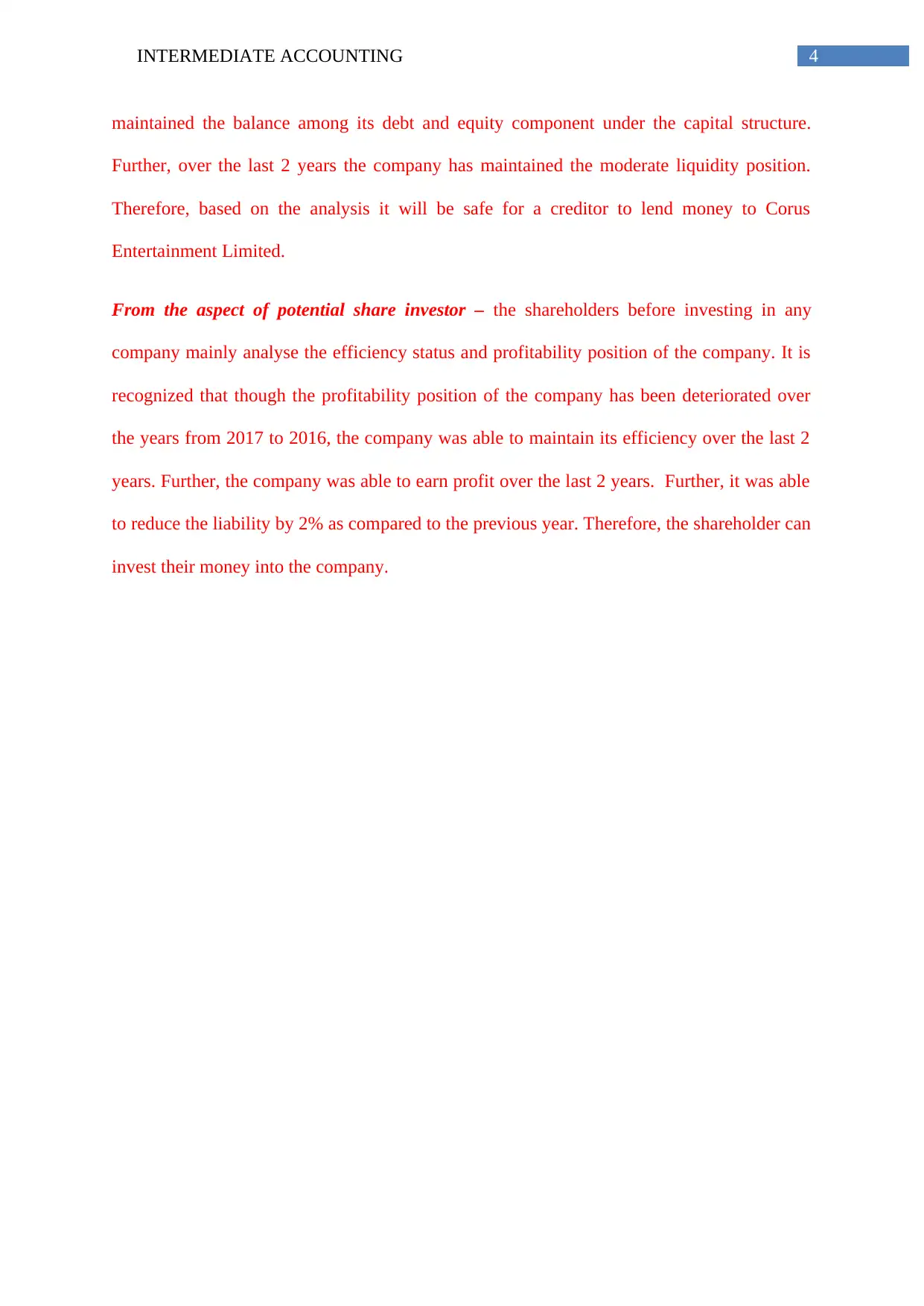
4INTERMEDIATE ACCOUNTING
maintained the balance among its debt and equity component under the capital structure.
Further, over the last 2 years the company has maintained the moderate liquidity position.
Therefore, based on the analysis it will be safe for a creditor to lend money to Corus
Entertainment Limited.
From the aspect of potential share investor – the shareholders before investing in any
company mainly analyse the efficiency status and profitability position of the company. It is
recognized that though the profitability position of the company has been deteriorated over
the years from 2017 to 2016, the company was able to maintain its efficiency over the last 2
years. Further, the company was able to earn profit over the last 2 years. Further, it was able
to reduce the liability by 2% as compared to the previous year. Therefore, the shareholder can
invest their money into the company.
maintained the balance among its debt and equity component under the capital structure.
Further, over the last 2 years the company has maintained the moderate liquidity position.
Therefore, based on the analysis it will be safe for a creditor to lend money to Corus
Entertainment Limited.
From the aspect of potential share investor – the shareholders before investing in any
company mainly analyse the efficiency status and profitability position of the company. It is
recognized that though the profitability position of the company has been deteriorated over
the years from 2017 to 2016, the company was able to maintain its efficiency over the last 2
years. Further, the company was able to earn profit over the last 2 years. Further, it was able
to reduce the liability by 2% as compared to the previous year. Therefore, the shareholder can
invest their money into the company.
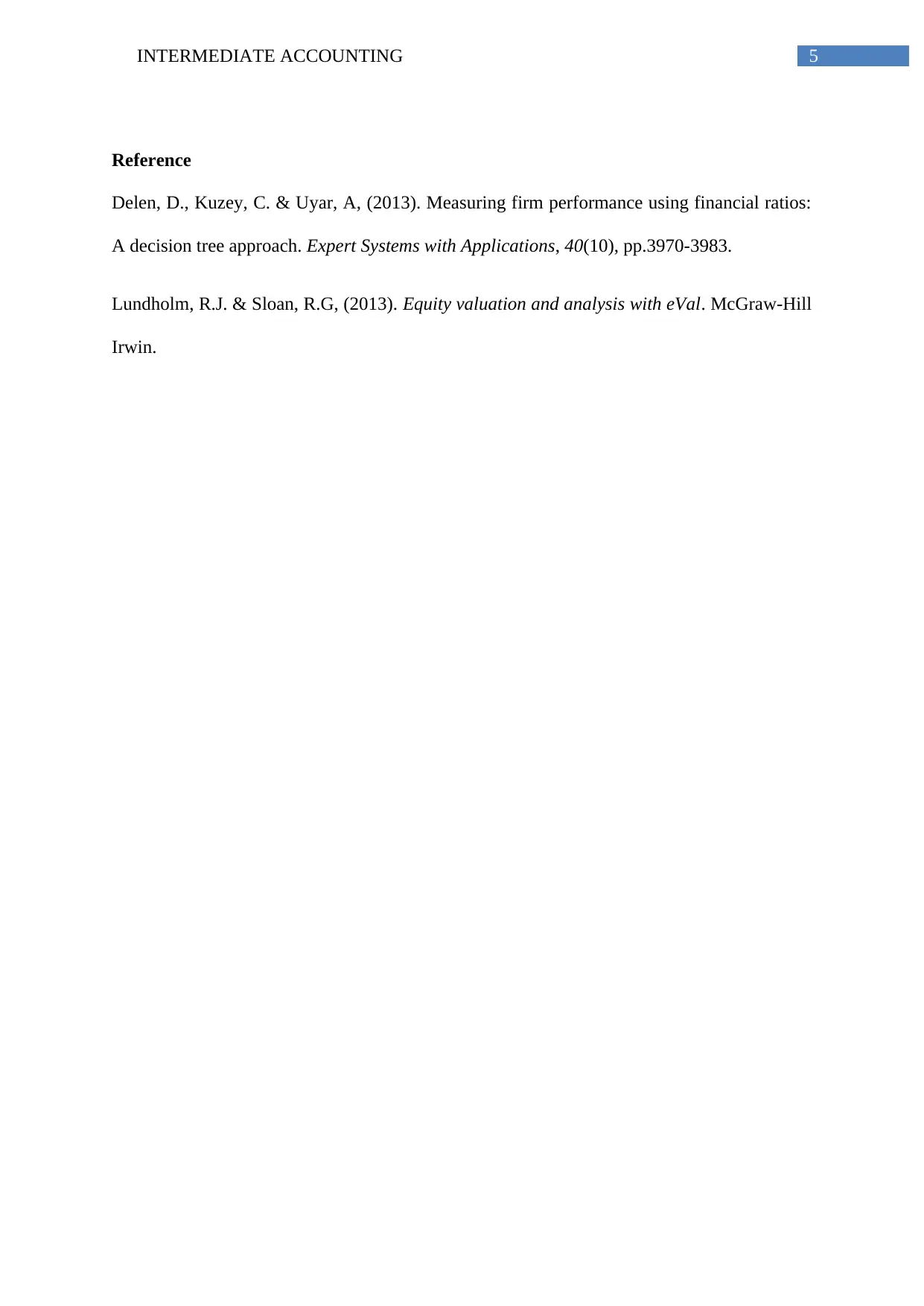
5INTERMEDIATE ACCOUNTING
Reference
Delen, D., Kuzey, C. & Uyar, A, (2013). Measuring firm performance using financial ratios:
A decision tree approach. Expert Systems with Applications, 40(10), pp.3970-3983.
Lundholm, R.J. & Sloan, R.G, (2013). Equity valuation and analysis with eVal. McGraw-Hill
Irwin.
Reference
Delen, D., Kuzey, C. & Uyar, A, (2013). Measuring firm performance using financial ratios:
A decision tree approach. Expert Systems with Applications, 40(10), pp.3970-3983.
Lundholm, R.J. & Sloan, R.G, (2013). Equity valuation and analysis with eVal. McGraw-Hill
Irwin.
⊘ This is a preview!⊘
Do you want full access?
Subscribe today to unlock all pages.

Trusted by 1+ million students worldwide
1 out of 6
Related Documents
Your All-in-One AI-Powered Toolkit for Academic Success.
+13062052269
info@desklib.com
Available 24*7 on WhatsApp / Email
![[object Object]](/_next/static/media/star-bottom.7253800d.svg)
Unlock your academic potential
Copyright © 2020–2025 A2Z Services. All Rights Reserved. Developed and managed by ZUCOL.





